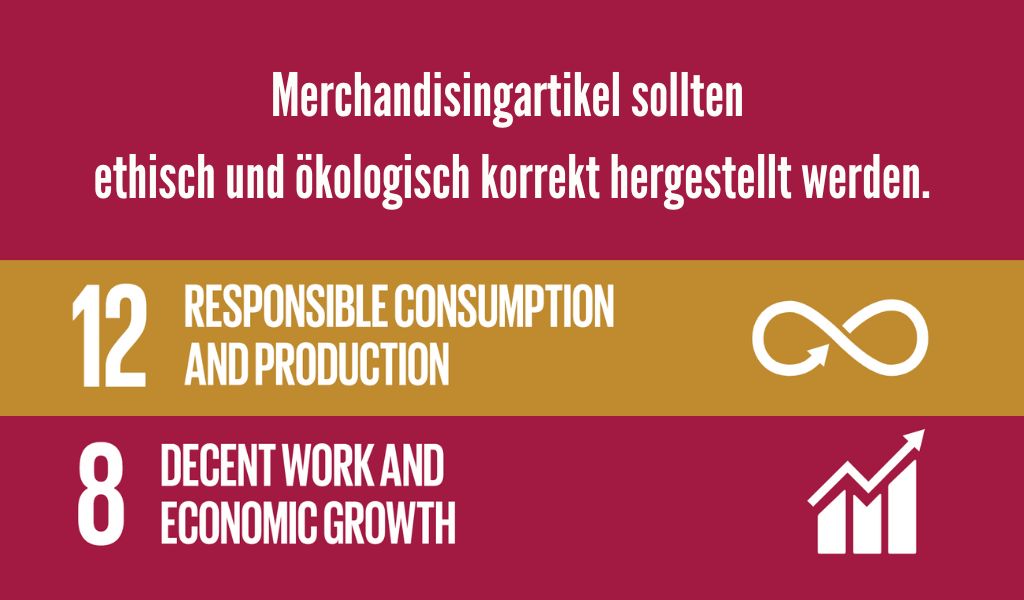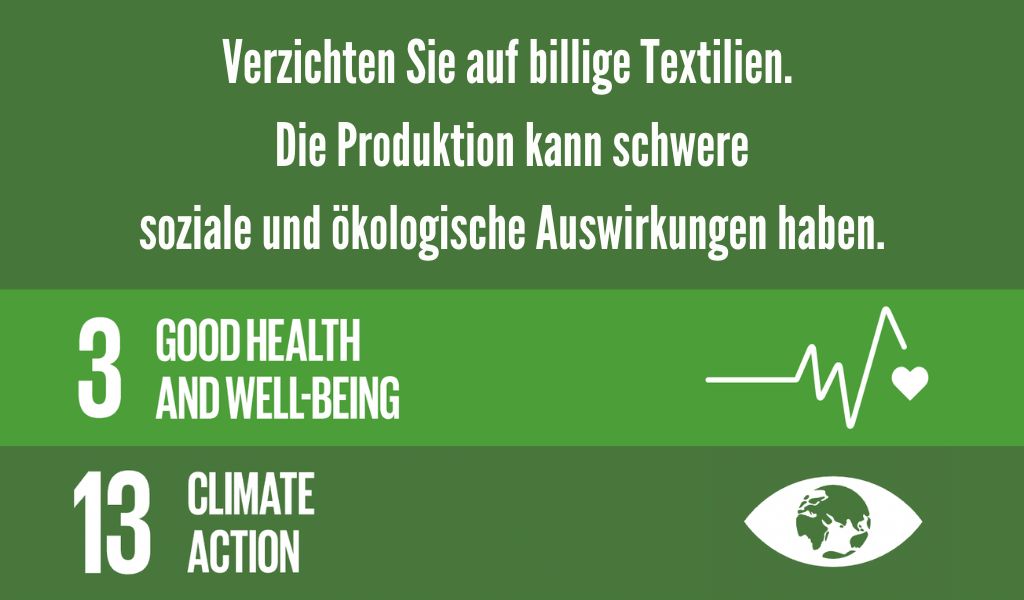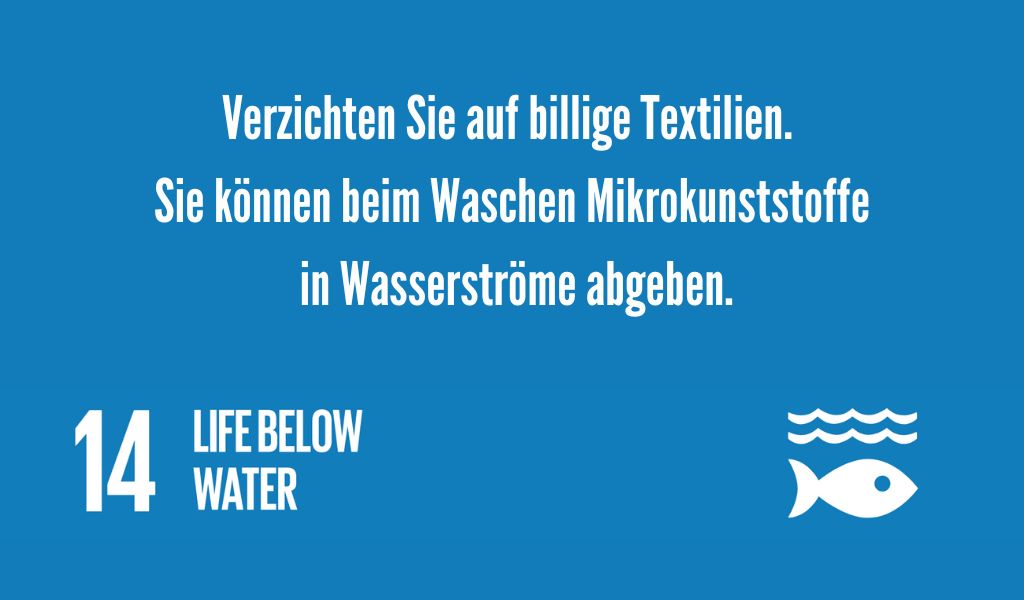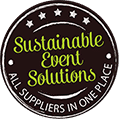Handtücher, Kleidung und Merchandisingartikel sollte aus Fasern, z.B. Bio-Baumwolle, bestehen und nachhaltig produziert werden. Zwar sind diese teurer als billige Alternativen, aber auch länger haltbar.
Billige Textilproduktionen können schwerwiegende soziale und ökologische Auswirkungen haben. Studien belegen, dass Kunststoffe beim Waschen Mikrokunststoffe in Wasserströme abgeben. Sie haben es in der Hand!
So zahlen Ihre Maßnahmen auf die SDGs ein:
- SDG3: Ein gesundes Leben für alle Menschen jeden Alters gewährleisten und ihr Wohlergehen fördern
Goal 3: Ensure healthy lives and promote well-being for all at all ages
3.9 Bis 2030 die Zahl der Todesfälle und Erkrankungen aufgrund gefährlicher Chemikalien und der Verschmutzung und Verunreinigung von Luft, Wasser und Boden erheblich verringern - SDG8: Dauerhaftes, breitenwirksames und nachhaltiges Wirtschaftswachstum, produktive Vollbeschäftigung und menschenwürdige Arbeit für alle fördern. Hinterfragen Sie die Herkunft Ihrer Arbeitsmaterialien.
Goal 8: Promote inclusive and sustainable economic growth, employment and decent work for all
8.4 Bis 2030 die weltweite Ressourceneffizienz in Konsum und Produktion Schritt für Schritt verbessern und die Entkopplung von Wirtschaftswachstum und Umweltzerstörung anstreben, im Einklang mit dem Zehnjahres-Programmrahmen für nachhaltige Konsum- und Produktionsmuster, wobei die entwickelten Länder die Führung übernehmen - SDG12: Nachhaltige Konsum- und Produktionsmuster sicherstellen
Goal 12: Ensure sustainable consumption and production patterns
12.2 Bis 2030 die nachhaltige Bewirtschaftung und effiziente Nutzung der natürlichen Ressourcen erreichen - SDG13: Umgehend Maßnahmen zur Bekämpfung des Klimawandels und seiner Auswirkungen ergreifen – Reduzieren Sie Ihren CO₂-Fußabdruck.
Goal 13: Take urgent action to combat climate change and its impacts - SDG14: Ozeane, Meere und Meeresressourcen im Sinne nachhaltiger Entwicklung erhalten und nachhaltig nutzen
Goal 14: Conserve and sustainably use the oceans, seas and marine resources
14.1 Bis 2025 alle Arten der Meeresverschmutzung, insbesondere durch vom Lande ausgehende Tätigkeiten und namentlich Meeresmüll und Nährstoffbelastung, verhüten und erheblich verringern. Vermeiden Sie Plastik.

Praxistipps für nachhaltige Merchandisingartikel
Die Produktion von Textilien und Merchandisingartikeln kann erhebliche Auswirkungen auf die Umwelt haben. Neben den Umweltauswirkungen sind auch die sozialen Auswirkungen der Textilproduktion ein zunehmendes Problem. Aus diesem Grund wird die Bedeutung von ethisch einwandfreien und biologischen Textilien und Merchandisingartikeln in der Veranstaltungswirtschaft und bei Firmenevents, Messen etc. immer wichtiger.
Die Verwendung von biologischen Materialien und ethisch einwandfreien Herstellungsprozessen kann dazu beitragen, die Umweltauswirkungen zu minimieren. Biologisch erzeugte Textilien verwenden keine synthetischen Chemikalien, Pestizide oder Düngemittel, die in konventionellen Baumwollplantagen häufig eingesetzt werden. Außerdem kann der Einsatz von biologisch erzeugten Textilien die Biodiversität fördern, indem er dazu beiträgt, den Einsatz von Pestiziden und Düngemitteln zu reduzieren. Darüber hinaus kann die Verwendung von Textilien und Merchandisingartikeln aus ethisch einwandfreien Quellen dazu beitragen, die sozialen Bedingungen in der Textilindustrie zu verbessern, indem sie faire Löhne und Arbeitsbedingungen gewährleisten.
Die Verwendung von biologisch erzeugten Textilien und Merchandisingartikeln kann auch wirtschaftliche Vorteile bieten. Unternehmen können sich von ihren Wettbewerbern differenzieren, indem sie auf ethisch einwandfreie und biologisch erzeugte Produkte setzen, was für ein positives Image sorgt und sich auf die Kundenzufriedenheit auswirkt. Darüber hinaus kann die Verwendung von nachhaltigen Materialien langfristig dazu beitragen, Kosten zu senken und den Verbrauch von Ressourcen zu reduzieren.

Rechtliche Vorgaben und Berichtspflichten werden auch immer wichtiger. Unternehmen müssen sicherstellen, dass ihre Lieferketten ethischen und nachhaltigen Standards entsprechen und darüber hinaus Berichte über ihre Nachhaltigkeitsmaßnahmen veröffentlichen. Die Einführung von Gesetzen wie dem deutschen Lieferkettengesetz, das Unternehmen dazu verpflichtet, die Einhaltung sozialer und ökologischer Standards in ihren Lieferketten sicherzustellen, unterstreicht die Wichtigkeit von nachhaltigen Lieferketten.
Insgesamt ist die Verwendung von ethisch einwandfreien und biologisch erzeugten Textilien und Merchandisingartikeln ein wichtiger Schritt zur Förderung von Nachhaltigkeit in der Veranstaltungswirtschaft und bei Firmenevents, Messen etc. Die Vorteile reichen von der Reduzierung von Umweltauswirkungen bis hin zu wirtschaftlichen Vorteilen und der Einhaltung gesetzlicher Vorgaben.
Auch aus ökonomischer Sicht ist der Einsatz von nachhaltigen Textilien und Merchandising sinnvoll. Durch den Einsatz von biologischen Materialien und der Verwendung von ressourcenschonenden Produktionsverfahren kann die Produktionskosten gesenkt werden. Zudem kann durch die Verwendung von nachhaltigen Materialien der Energie- und Wasserverbrauch reduziert werden, was auch zu Kosteneinsparungen führt.
Insgesamt ist die Verwendung von biologischen Textilien und Merchandising also nicht nur aus ökologischer, sondern auch aus sozialer und wirtschaftlicher Sicht von großer Bedeutung. Unternehmen sollten sich daher bewusst sein, dass nachhaltige Lieferketten einen erheblichen Beitrag zur Verbesserung der Umwelt- und sozialen Standards leisten können, während gleichzeitig auch wirtschaftliche Vorteile erzielt werden können.
Beispiele für nachhaltige Merchandisingartikel bei Veranstaltungen
Ethical Fashion Show Berlin
Diese Messe ist der größte Treffpunkt für nachhaltige Mode in Europa und bietet nachhaltigen Modedesignern und -labels eine Plattform. Sie setzt sich für eine Veränderung der Modebranche ein und präsentiert innovative Ansätze für eine nachhaltige Lieferkette.
Green Shows at New York Fashion Week
Im Rahmen der New York Fashion Week finden jedes Jahr auch Green Shows statt, bei denen nachhaltige und ethisch einwandfreie Mode präsentiert wird. Diese Shows setzen ein Zeichen für eine umwelt- und sozialverträglichere Modeindustrie.
Sustainable Apparel Coalition
Die Sustainable Apparel Coalition (SAC) ist ein Zusammenschluss von Unternehmen, NGOs und Regierungen, die sich für eine nachhaltigere Textilindustrie einsetzen. Die jährliche Mitgliederversammlung ist eine wichtige Veranstaltung für die Branche.
Textile Exchange Sustainability Conference
Die Textile Exchange Sustainability Conference ist eine jährliche Konferenz für Unternehmen und Organisationen, die sich für eine nachhaltigere Textilindustrie einsetzen. Die Veranstaltung bietet Workshops, Vorträge und Diskussionen zu aktuellen Themen rund um nachhaltige Lieferketten und Textilien.
Corporate Responsibility and Sustainability Conference
Diese Konferenz richtet sich an Unternehmen, die ihre Geschäftsprozesse nachhaltiger gestalten möchten. Eines der Hauptthemen ist die Umsetzung einer nachhaltigen Lieferkette, einschließlich der Beschaffung von nachhaltigen Textilien und Merchandisingartikeln.

Jetzt sind Sie dran – wie sorgen Sie für nachhaltige Merchandisingartikel bei Ihrer Veranstaltung?
Lassen Sie es mich wissen, wie Sie für nachhaltige Merchandisingartikel bei Ihrer Veranstaltung gesorgt haben oder wie Sie dies künftig tun wollen.
- Verzichten Sie auf billige Textilien oder Merchandisingartikel?
- Erfragen Sie die Herkunft und Herstellung von Merchandisingartikeln für Ihr Event?
- Setzen Sie auch bei Team-T-Shirts oder bei der Auswahl des Hotels auf nachhaltige Textilien?
Diskutieren Sie mit mir – zum Beispiel direkt auf meinem LinkedIn-Profil.

Holen Sie sich am besten gleich den kostenfreien Sustainability Rider und entdecken Sie, was Sie schon heute für nachhaltige Veranstaltungen tun können.


